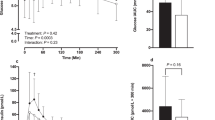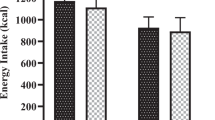Abstract
Objective:
We investigated the effects of whey protein (WP), pea protein hydrolysate (PPH), a combination of WP+PPH and control (milk protein (MP) which consists of 80% casein and 20% WP) on appetite ratings, postprandial changes in hunger/satiety hormones and energy intake (EI).
Design:
A randomized, crossover design which consisted of 2 parts (experiment 1 and 2). The peptides to be tested were provided as part of a shake (1024 kJ; en% P/F/C: 25/33/42) which contained either 15 g WP, 15 g PPH, a combination of 7.5 g WP and 7.5 g PPH (WP+PPH) or 15 g MP.
Subjects:
39 subjects (BMI: 27.6±1.7 kg m−2; age: 42.3±13.8 years).
Measurements:
In experiment 1 (duration 4 h), appetite profile was measured and blood samples were taken for analysis of hunger/satiety hormones and glucose. In experiment 2 (duration 7 h), appetite profile and EI (180 min after consumption of the shake) were measured.
Results:
Some indications of lower hunger (experiment 1), desire to eat (experiment 2) and thirst (experiment 1 and 2) were shown after consumption of PPH compared to MP or WP+PPH (P<0.05). A longer intermeal interval and a higher satiety index were suggested after consumption of PPH. Both PPH and WP lead to greater satiety (experiment 2) and fullness (experiment 2) compared to MP and WP+PPH (P<0.05). For WP, a positive correlation between insulin and both cholecystokinine (CCK) and glucagon like peptide-1 (GLP-1) was observed (P<0.05). However, both CCK and GLP-1 were increased by MP (P<0.05), peptide YY (PYY) was stimulated by WP+PPH, while the decline in ghrelin was larger (P<0.05). No effect on EI was seen.
Conclusion:
There was modest evidence with respect to satiety by PPH consumption. Different exogenous biopeptides produced differences in release of endogenous peptides that had inconsistent relationships with satiety. Therefore, evidence derived from a supposed biomarker for satiety does not guarantee the highest satiety.
This is a preview of subscription content, access via your institution
Access options
Subscribe to this journal
Receive 12 print issues and online access
$259.00 per year
only $21.58 per issue
Buy this article
- Purchase on Springer Link
- Instant access to full article PDF
Prices may be subject to local taxes which are calculated during checkout



Similar content being viewed by others
References
Poppitt SD, McCormack D, Buffenstein R . Short-term effects of macronutrient preloads on appetite and energy intake in lean women. Physiol Behav 1998; 64: 279–285.
Weigle DS, Breen PA, Matthys CC, Callahan HS, Meeuws KE, Burden VR et al. A high-protein diet induces sustained reductions in appetite, ad libitum caloric intake, and body weight despite compensatory changes in diurnal plasma leptin and ghrelin concentrations. Am J Clin Nutr 2005; 82: 41–48.
Anderson GH, Moore SE . Dietary proteins in the regulation of food intake and body weight in humans. J Nutr 2004; 134: 974S–979S.
Hall WL, Millward DJ, Long SJ, Morgan LM . Casein and whey exert different effects on plasma amino acid profiles, gastrointestinal hormone secretion and appetite. Br J Nutr 2003; 89: 239–248.
Lang V, Bellisle F, Alamowitch C, Craplet C, Bornet FR, Slama G et al. Varying the protein source in mixed meal modifies glucose, insulin and glucagon kinetics in healthy men, has weak effects on subjective satiety and fails to affect food intake. Eur J Clin Nutr 1999; 53: 959–965.
Lang V, Bellisle F, Oppert JM, Craplet C, Bornet FR, Slama G et al. Satiating effect of proteins in healthy subjects: a comparison of egg albumin, casein, gelatin, soy protein, pea protein, and wheat gluten. Am J Clin Nutr 1998; 67: 1197–1204.
Uhe AM, Collier GR, O'Dea K . A comparison of the effects of beef, chicken and fish protein on satiety and amino acid profiles in lean male subjects. J Nutr 1992; 122: 467–472.
Anderson GH, Tecimer SN, Shah D, Zafar TA . Protein source, quantity, and time of consumption determine the effect of proteins on short-term food intake in young men. J Nutr 2004; 134: 3011–3015.
Bowen J, Noakes M, Clifton PM . Appetite regulatory hormone responses to various dietary proteins differ by body mass index status despite similar reductions in ad libitum energy intake. J Clin Endocrinol Metab 2006; 91: 2913–2919.
Cummings DE, Overduin J . Gastrointestinal regulation of food intake. J Clin Invest 2007; 117: 13–23.
Adam TC, Westerterp-Plantenga MS . Nutrient-stimulated GLP-1 release in normal-weight men and women. Horm Metab Res 2005; 37: 111–117.
Bowen J, Noakes M, Trenerry C, Clifton PM . Energy intake, ghrelin, and cholecystokinin after different carbohydrate and protein preloads in overweight men. J Clin Endocrinol Metab 2006; 91: 1477–1483.
Elliott RM, Morgan LM, Tredger JA, Deacon S, Wright J, Marks V . Glucagon-like peptide-1 (7-36)amide and glucose-dependent insulinotropic polypeptide secretion in response to nutrient ingestion in man: acute post-prandial and 24-h secretion patterns. J Endocrinol 1993; 138: 159–166.
Erdmann J, Lippl F, Schusdziarra V . Differential effect of protein and fat on plasma ghrelin levels in man. Regul Pept 2003; 116: 101–107.
Erdmann J, Topsch R, Lippl F, Gussmann P, Schusdziarra V . Postprandial response of plasma ghrelin levels to various test meals in relation to food intake, plasma insulin, and glucose. J Clin Endocrinol Metab 2004; 89: 3048–3054.
Greenman Y, Golani N, Gilad S, Yaron M, Limor R, Stern N . Ghrelin secretion is modulated in a nutrient- and gender-specific manner. Clin Endocrinol (Oxf) 2004; 60: 382–388.
Raben A, Agerholm-Larsen L, Flint A, Holst JJ, Astrup A . Meals with similar energy densities but rich in protein, fat, carbohydrate, or alcohol have different effects on energy expenditure and substrate metabolism but not on appetite and energy intake. Am J Clin Nutr 2003; 77: 91–100.
Ritzel U, Fromme A, Ottleben M, Leonhardt U, Ramadori G . Release of glucagon-like peptide-1 (GLP-1) by carbohydrates in the perfused rat ileum. Acta Diabetol 1997; 34: 18–21.
Batterham RL, Heffron H, Kapoor S, Chivers JE, Chandarana K, Herzog H et al. Critical role for peptide YY in protein-mediated satiation and body-weight regulation. Cell Metab 2006; 4: 223–233.
Gerhardt CC, Tasker MC . Satiety Inducing Composition. Unilever: The Netherlands, 2005, pp.
Stunkard AJ, Messick S . The three-factor eating questionnaire to measure dietary restraint, disinhibition and hunger. J Psychosom Res 1985; 29: 71–83.
Schoeller DA, van Santen E, Peterson DW, Dietz W, Jaspan J, Klein PD . Total body water measurement in humans with 18O and 2H labeled water. Am J Clin Nutr 1980; 33: 2686–2693.
van Marken Lichtenbelt WD, Westerterp KR, Wouters L . Deuterium dilution as a method for determining total body water: effect of test protocol and sampling time. Br J Nutr 1994; 72: 491–497.
Westerterp KR, Wouters L, van Marken Lichtenbelt WD . The Maastricht protocol for the measurement of body composition and energy expenditure with labeled water. Obes Res 1995; 3 (suppl 1): 49–57.
Stubbs RJ, Hughes DA, Johnstone AM, Rowley E, Reid C, Elia M et al. The use of visual analogue scales to assess motivation to eat in human subjects: a review of their reliability and validity with an evaluation of new hand-held computerized systems for temporal tracking of appetite ratings. Br J Nutr 2000; 84: 405–415.
Kovacs EM, Lejeune MP, Westerterp-Plantenga MS . The effects of enterostatin intake on food intake and energy expenditure. Br J Nutr 2003; 90: 207–214.
Adam TC, Lejeune MP, Westerterp-Plantenga MS . Nutrient-stimulated glucagon-like peptide 1 release after body-weight loss and weight maintenance in human subjects. Br J Nutr 2006; 95: 160–167.
Morinigo R, Moize V, Musri M, Lacy AM, Navarro S, Marin JL et al. Glucagon-like peptide-1, peptide YY, hunger, and satiety after gastric bypass surgery in morbidly obese subjects. J Clin Endocrinol Metab 2006; 91: 1735–1740.
Batterham RL, Cohen MA, Ellis SM, Le Roux CW, Withers DJ, Frost GS et al. Inhibition of food intake in obese subjects by peptide YY3-36. N Engl J Med 2003; 349: 941–948.
Billeaud C, Guillet J, Sandler B . Gastric emptying in infants with or without gastro-oesophageal reflux according to the type of milk. Eur J Clin Nutr 1990; 44: 577–583.
Miller MJ, Witherly SA, Clark DA . Casein: a milk protein with diverse biologic consequences. Proc Soc Exp Biol Med 1990; 195: 143–159.
Boirie Y, Dangin M, Gachon P, Vasson MP, Maubois JL, Beaufrere B . Slow and fast dietary proteins differently modulate postprandial protein accretion. Proc Natl Acad Sci USA 1997; 94: 14930–14935.
Gannon MC, Nuttall FQ, Neil BJ, Westphal SA . The insulin and glucose responses to meals of glucose plus various proteins in type II diabetic subjects. Metabolism 1988; 37: 1081–1088.
Layman DK, Baum JI . Dietary protein impact on glycemic control during weight loss. J Nutr 2004; 134: 968S–973S.
van Loon LJ, Saris WH, Verhagen H, Wagenmakers AJ . Plasma insulin responses after ingestion of different amino acid or protein mixtures with carbohydrate. Am J Clin Nutr 2000; 72: 96–105.
Schilstra AJ . Meal-interval correlations: what can they tell us? Physiol Behav 1981; 27: 299–304.
Himaya A, Louis-Sylvestre J . The effect of soup on satiation. Appetite 1998; 30: 199–210.
Senn S . Change from baseline and analysis of covariance revisited. Stat Med 2006; 25: 4334–4344.
Acknowledgements
We gratefully thank Myrtha Arnold, Rachel Batterham, Patrick Egelmeers, Annemiek Joosen, Wolfgang Langhans, Manuela Lejeune, Natalie Luscombe-Marsh, David Mela, Anthony Moses, Wendy Sluijsmans, Astrid Smeets, Jos Stegen and Loek Wouters for their contributions to the study and the manuscript.
The study was supported by a grant from Technological Collaboration, obtained by Unilever Food and Health Research Institute, Unilever R&D Vlaardingen, Vlaardingen, The Netherlands, DSM Food Specialties, Delft, The Netherlands and Nutrim, Maastricht University, Maastricht, The Netherlands. No author had any personal or financial relation with the companies funding this research.
Author information
Authors and Affiliations
Corresponding author
Rights and permissions
About this article
Cite this article
Diepvens, K., Häberer, D. & Westerterp-Plantenga, M. Different proteins and biopeptides differently affect satiety and anorexigenic/orexigenic hormones in healthy humans. Int J Obes 32, 510–518 (2008). https://doi.org/10.1038/sj.ijo.0803758
Received:
Revised:
Accepted:
Published:
Issue Date:
DOI: https://doi.org/10.1038/sj.ijo.0803758
Keywords
This article is cited by
-
Postprandial effects of dietary protein source on metabolic responses, appetite, and arterial stiffness indices in overweight and obese men: the study protocol for a randomized crossover clinical trial
Trials (2023)
-
The acute effects of insect vs. beef-derived protein on postprandial plasma aminoacidemia, appetite hormones, appetite sensations, and energy intake in healthy young men
European Journal of Clinical Nutrition (2022)
-
Comparable effects of breakfast meals varying in protein source on appetite and subsequent energy intake in healthy males
European Journal of Nutrition (2018)
-
Influence of rice, pea and oat proteins in attenuating glycemic response of sugar-sweetened beverages
European Journal of Nutrition (2018)
-
Effects of low-fat milk consumption at breakfast on satiety and short-term energy intake in 10- to 12-year-old obese boys
European Journal of Nutrition (2016)



